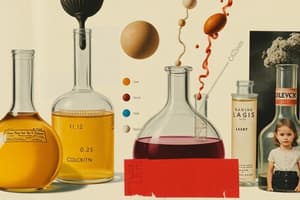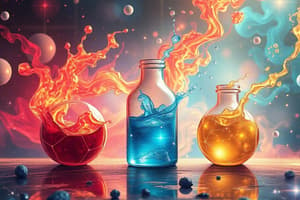Podcast
Questions and Answers
Consider a scenario where a chemist measures the volume of a gas at different temperatures and pressures. Which combination of accuracy and precision would be MOST beneficial for predicting gas behavior under varying conditions, as described by the ideal gas law?
Consider a scenario where a chemist measures the volume of a gas at different temperatures and pressures. Which combination of accuracy and precision would be MOST beneficial for predicting gas behavior under varying conditions, as described by the ideal gas law?
- Low accuracy and high precision, providing consistent measurements, even if they deviate from the true value.
- High accuracy and low precision, ensuring the average measurement closely reflects the true value, despite variability.
- High accuracy and high precision, yielding measurements that are both close to the true value and consistently reproducible. (correct)
- Low accuracy and low precision, accepting a wide range of measurements with no guarantee of closeness to the true value.
A researcher synthesizes a novel compound and aims to determine its empirical formula through combustion analysis. The data reveals the compound contains carbon, hydrogen, and oxygen. Which approach would BEST ensure an accurate determination of the empirical formula?
A researcher synthesizes a novel compound and aims to determine its empirical formula through combustion analysis. The data reveals the compound contains carbon, hydrogen, and oxygen. Which approach would BEST ensure an accurate determination of the empirical formula?
- Use the unadjusted raw data from the combustion analysis to calculate the empirical formula to avoid potential calculation errors.
- Calculate the mole ratios of carbon and hydrogen directly from the mass percentages, assuming oxygen's contribution is negligible.
- Determine the mass percentages of carbon and hydrogen, then subtract their sum from 100% to find the mass percentage of oxygen; proceed with mole ratio calculations. (correct)
- Estimate the empirical formula based on the colors of the flames observed during the combustion process, without quantitative analysis.
Consider two aqueous solutions: Solution A contains a weak acid and its conjugate base, while Solution B contains a strong acid at the same concentration as the weak acid in Solution A. How does the pH of Solution A compare to the pH of Solution B?
Consider two aqueous solutions: Solution A contains a weak acid and its conjugate base, while Solution B contains a strong acid at the same concentration as the weak acid in Solution A. How does the pH of Solution A compare to the pH of Solution B?
- The pH values of Solutions A and B are equal because the concentrations of the acids are the same.
- Solution A has a higher pH because the weak acid only partially dissociates, and the conjugate base can accept hydrogen ions. (correct)
- The pH of Solution A is approximately 7, as the effect of the weak acid is negligible.
- Solution A has a lower pH because the weak acid completely dissociates, resulting in a higher concentration of hydrogen ions.
In a chemical reaction at equilibrium, the forward reaction is endothermic. According to Le Chatelier's principle, which change would shift the equilibrium towards the products?
In a chemical reaction at equilibrium, the forward reaction is endothermic. According to Le Chatelier's principle, which change would shift the equilibrium towards the products?
A chemist is tasked with synthesizing a complex organic molecule that requires a specific stereoisomer as a reactant. During the reaction, it is observed that the product mixture contains a racemic mixture instead of the desired stereoisomer. Which factor would most likely explain the loss of stereochemical control?
A chemist is tasked with synthesizing a complex organic molecule that requires a specific stereoisomer as a reactant. During the reaction, it is observed that the product mixture contains a racemic mixture instead of the desired stereoisomer. Which factor would most likely explain the loss of stereochemical control?
Consider a scenario where a compound containing carbon, hydrogen, and a halogen undergoes nucleophilic substitution. Which halogen would MOST likely result in the fastest reaction rate, assuming all other conditions remain constant?
Consider a scenario where a compound containing carbon, hydrogen, and a halogen undergoes nucleophilic substitution. Which halogen would MOST likely result in the fastest reaction rate, assuming all other conditions remain constant?
When measuring the pH of a buffer solution, a scientist finds that the measured pH deviates significantly from the pH calculated using the Henderson-Hasselbalch equation. Which factor could account for this discrepancy?
When measuring the pH of a buffer solution, a scientist finds that the measured pH deviates significantly from the pH calculated using the Henderson-Hasselbalch equation. Which factor could account for this discrepancy?
In a galvanic cell, the standard reduction potentials for two half-reactions are:
$Cu^{2+}(aq) + 2e^- \rightarrow Cu(s) \quad E = +0.34 V$
$Zn^{2+}(aq) + 2e^- \rightarrow Zn(s) \quad E = -0.76 V$
What is the standard cell potential ($E_{cell}$) for the spontaneous reaction?
In a galvanic cell, the standard reduction potentials for two half-reactions are:
$Cu^{2+}(aq) + 2e^- \rightarrow Cu(s) \quad E = +0.34 V$ $Zn^{2+}(aq) + 2e^- \rightarrow Zn(s) \quad E = -0.76 V$
What is the standard cell potential ($E_{cell}$) for the spontaneous reaction?
A system at equilibrium is subjected to a sudden decrease in volume. According to Le Chatelier's principle, which type of reaction will be favored?
A system at equilibrium is subjected to a sudden decrease in volume. According to Le Chatelier's principle, which type of reaction will be favored?
A researcher attempts to synthesize a chiral molecule using a reaction that involves a carbocation intermediate. Despite using optically pure starting materials, the final product is racemic. What is the MOST likely explanation for this outcome?
A researcher attempts to synthesize a chiral molecule using a reaction that involves a carbocation intermediate. Despite using optically pure starting materials, the final product is racemic. What is the MOST likely explanation for this outcome?
Consider a plot of a titration curve for a diprotic acid ((H_2A)) with a strong base. What is the significance of the two equivalence points?
Consider a plot of a titration curve for a diprotic acid ((H_2A)) with a strong base. What is the significance of the two equivalence points?
During a calorimetry experiment, a chemical reaction occurs in an insulated container, and the temperature of the water surrounding the reaction changes. If the calorimeter itself absorbs a significant amount of heat, how would this affect the calculation of the enthalpy change ((H)) for the reaction?
During a calorimetry experiment, a chemical reaction occurs in an insulated container, and the temperature of the water surrounding the reaction changes. If the calorimeter itself absorbs a significant amount of heat, how would this affect the calculation of the enthalpy change ((H)) for the reaction?
In chemical kinetics, the rate of a reaction is found to increase significantly with a small increase in temperature. Which statement BEST explains this observation?
In chemical kinetics, the rate of a reaction is found to increase significantly with a small increase in temperature. Which statement BEST explains this observation?
Two volatile liquids, A and B, form a solution that exhibits positive deviations from Raoult's law. Which statement correctly describes the interactions between the molecules?
Two volatile liquids, A and B, form a solution that exhibits positive deviations from Raoult's law. Which statement correctly describes the interactions between the molecules?
A researcher is studying an enzyme-catalyzed reaction and observes that the reaction rate reaches a maximum value that cannot be increased further by adding more substrate. This phenomenon is known as saturation kinetics. Which factor BEST explains why the reaction rate plateaus at high substrate concentrations?
A researcher is studying an enzyme-catalyzed reaction and observes that the reaction rate reaches a maximum value that cannot be increased further by adding more substrate. This phenomenon is known as saturation kinetics. Which factor BEST explains why the reaction rate plateaus at high substrate concentrations?
Flashcards
Chemistry
Chemistry
The study of matter and its properties and how matter changes.
Solid
Solid
Matter with a definite shape and volume.
Homogeneous Mixture
Homogeneous Mixture
A homogeneous combination of two or more substances.
Element
Element
Signup and view all the flashcards
Physical Property
Physical Property
Signup and view all the flashcards
Significant Figures
Significant Figures
Signup and view all the flashcards
Protons
Protons
Signup and view all the flashcards
Isotopes
Isotopes
Signup and view all the flashcards
Groups (Families)
Groups (Families)
Signup and view all the flashcards
Ionic Bond
Ionic Bond
Signup and view all the flashcards
Reactants
Reactants
Signup and view all the flashcards
Mole
Mole
Signup and view all the flashcards
Limiting Reactant
Limiting Reactant
Signup and view all the flashcards
Molarity (M)
Molarity (M)
Signup and view all the flashcards
Bronsted-Lowry Acid
Bronsted-Lowry Acid
Signup and view all the flashcards
Study Notes
The provided text contains the same information as the existing notes. Therefore, no updates are needed.
Studying That Suits You
Use AI to generate personalized quizzes and flashcards to suit your learning preferences.




